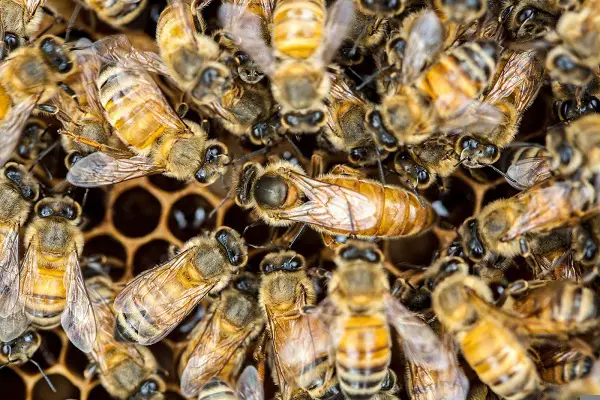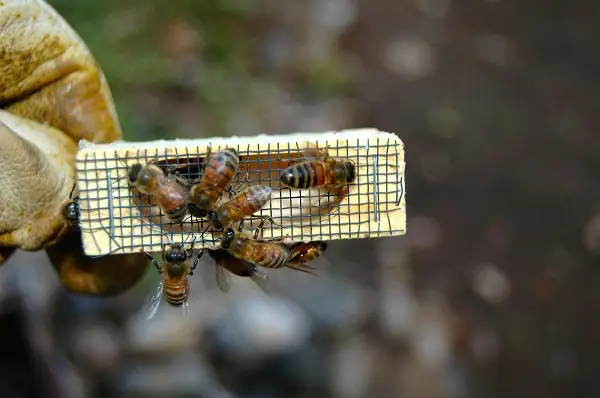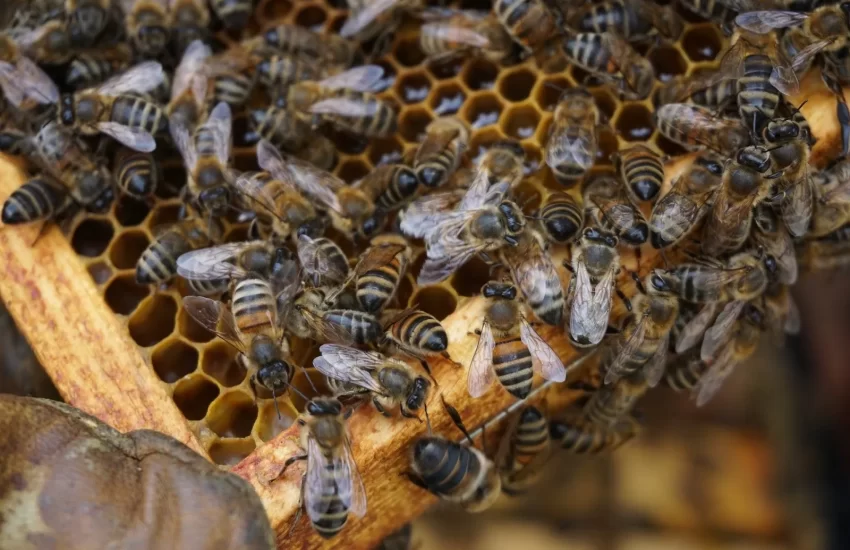How to requeen a beehive? When The Queen Dies
A healthy queen can live up to 5 years. However, as she ages, her productivity declines. She may also get lost or die. Most beekeepers replace a queen after every 1 or 2 years. Queenlessness is one of the most common ways to lose your colony, especially for new beekeepers.
Similar Articles you may like to read –
Can a hive live without a queen? How can you tell a Queenless hive?
Are queen bees born or made?
How long do queen bees live?
How Many Times Does A Queen Bee Get Mated?
What Happens When a Queen Bee Dies?
How to Know that your Bee Colony is Queenless
Lack of Eggs and Brood
The queen is the only bee in the hive that can lay fertilized eggs. She may be missing if there are no fresh laid eggs or young brood in the colony.
A Decline in Population
Workers bees have a short life span and die every day due to natural and unnatural causes. In a colony with a productive queen, they will be replaced, and you will not discover any variation in the population. However, when the queen is missing, she will not be replaced leading to a declining population.
Change in Temperament
Bees in a queenless colony are usually more aggressive than usual.
Presence of Queen Caps
When a colony becomes queenless, the bees will immediately attempt to replace the queen. Sometimes the bees may succeed in raising a new queen, while on other occasions, they may fail.
Increased Number of Drones
With the absence of queens’ pheromones, the workers may start to lay eggs. Since the eggs are sterile, they will result in drone bees.
Increase in Honey and pollen
If the hive is queenless, the young worker bees will join other foragers in the field. The bees will store honey even in areas where brood should be.
How to Introduce a New Queen in Your Colony
There are two methods of replacing a queen; direct and indirect method.
Direct Method
The direct method is when the queen is released into the colony immediately. This is not usually an excellent way to introduce her. Unless the colony is desperate for the queen, they will “ball” and kill her. She does not have the colony odor and is considered an intruder. That’s why it is essential to place her in a cage until she acquires the same odor as the colony. Some ways you can apply to increase acceptance indirect method
- Placing some honey on the queen and then introducing her to the colony. The worker bees will clean her and most likely accept her.
- First spraying the hive with sugar water mixed with peppermint extract. The smell neutralizes the queen’s pheromones and decreases the chances of attacking the queen.
- Introducing the new queen with smoke. You puff more smoke in the hive than you do during the inspection.
Indirect Method

In this method, the queen is introduced to the colony slowly. It takes several days for the bees to familiarize themselves and accept her. The queen is introduced in a cage. One end of the cage is blocked with a candy plug. Over several days, the bees slowly feed on the candy to free the queen. By the time the parties meet, the bees are already used to the queen’s pheromones. If the candy plug is hard and dry, you can consider making a small hall with a toothpick or small nail.
How to Install the Queen in the Hive?
You should first ensure that the colony has enough bees to maintain the hive in the requeening process. If the colony is weak, you can add a frame of brood from another colony.
You should place the queen cage between two frames in the hive. The queen comes with a few workers in the cage to take care of her during transit. Before introducing the queen to the colony, you must eliminate the workers since they reduce the queen’s chances of being accepted. Ensure you choose the frames in the brood area. The candy end should face up. It is advisable to use a rubber band around the entire frame to secure the cage. The bees eat the candy and release the queen within a few days. It is advisable to feed the bees when you are requeening the if there is no nectar flow. When food is plenty, the bees are more receptive to a replacement.
Checking the Queen Acceptance
After installing the cage, you should check after 3 and 7 days.
3 Days
After three days, you should conduct the first inspection to check if the queen has been released. If she is still in the cage, gauge the acceptance by the colony, and if positive, the go-ahead to release her. If the bees are holding on to the cage and trying to sting her, and it seems hard to move them, you push them away; they have not yet accepted her. However, if the bees around the cage seem calm and can be pushed aside easily, they have already accepted the queen. You can use a nail to create a hole in the candy. This will help her release.
Seven days
After seven days, the released queen should be lying. If you notice the queen walking around or realize new eggs have been laid, the queen has been accepted. You can now remove the cage and position the frames you pushed properly. You should check for supersedure cells and remove them if present. The worker bees may try to overthrow the queen and make a new queen.
Should you replace your hive with a mated or unmated queen?

While you can replace your hive with a virgin queen, choosing one already mated and already laying is perfect. This provides the best outcome. Mated queens are available from many bee supply companies. You will also have an opportunity to choose your desired bee breed if you want to inject some new bee genetics into your colony.
What happens when a colony rejects a queen?
If the queen is rejected, she will eventually die. The workers form a ball around her and sting her until she dies. If the queen survives this initial attack, she might stay longer, and the other bees may finally accept her.
How to Requeen A Hive Naturally?
When you are not in a position to purchase a new queen, and your colony does not have fresh eggs or larvae, you can help the bees to requeen a hive. You can take a frame containing fresh eggs and young larvae from another colony and add it to the queenless colony. However, the queenless colony must have a large population to rear a healthy replacement.
Some Reasons Why Beekeepers Replace a Queen Bee
- When the current queen is underperforming or non-reproductive
- A dead or missing queen
- When a beekeeper wants to introduce new genetics in a bee colony for an instant when the colony becomes too defensive.
How to Protect the Queen Bee
- Remove the queen cells if the current queen is performing well
- Use a queen bee excluder
- Clean the hive often
- Provide medication for your colony when necessary
- Split the hive only when it is necessary.
More articles you may like to read –
Do Bees Recognize Their Owners?
Do Bees Try To Get Revenge?
What Temperature Is Too Cold For Bees?
Do Bees Fly In The Rain? Where Do Bees Go When It Rains?
FAQs
Why would bees reject a queen?
The most common cause of queen rejection is when the older worker bees see the queen as invaders and not part of the colony. It happens when a beekeeper replaces a queen.
Why does a bee colony require a queen?
The queen bee plays a significant role in the hive by laying eggs. She is the only one with fully developed reproductive organs. She also produces pheromones that help to regulate the unity of the colony.
Can a colony survive without a queen?
A queen is required for the colony to grow and survive. Without her, the bee population will eventually die out.
How long can you keep a queen in a cage?
Caged queens can be kept for about ten days. They usually lose their quality when kept for long without laying eggs.
What is a “queenright” colony?
This is a colony with a queen.
What is supersedure?
This is when a colony takes action to requeen itself.


